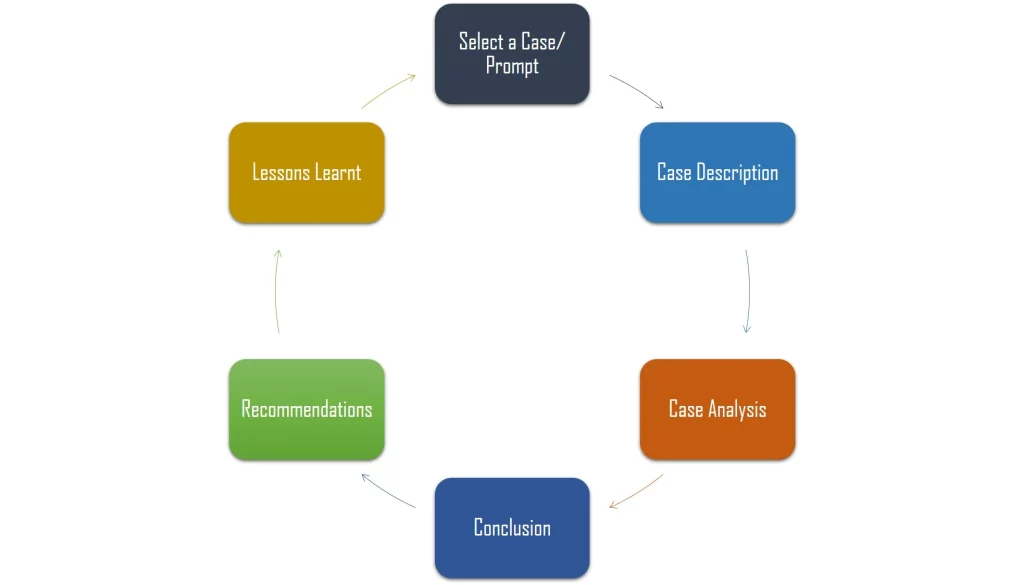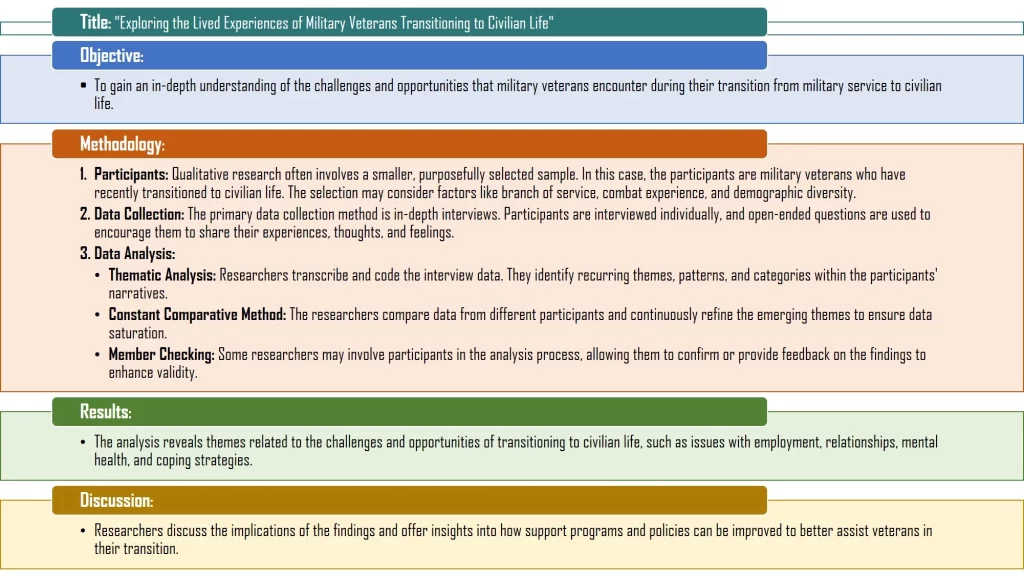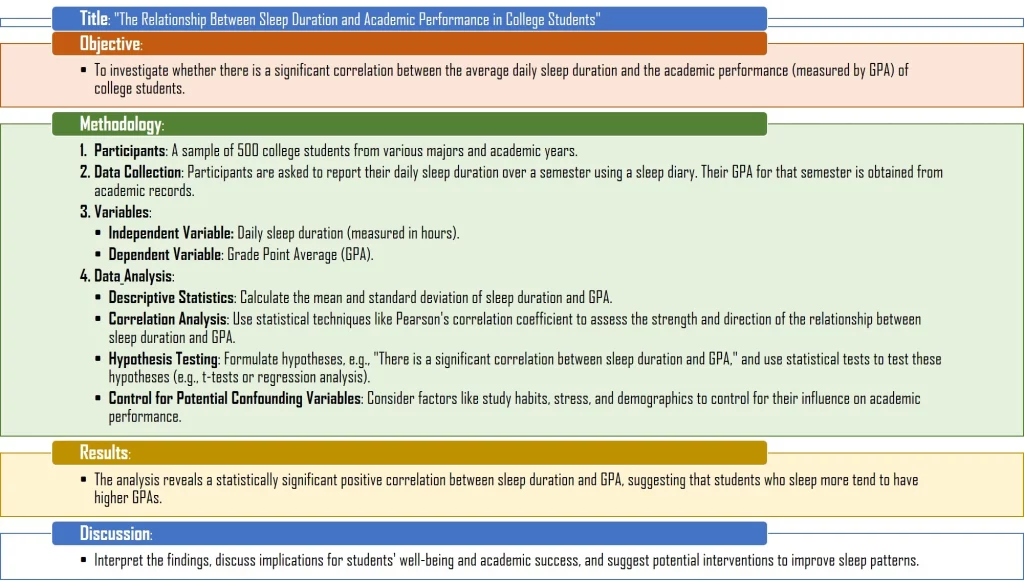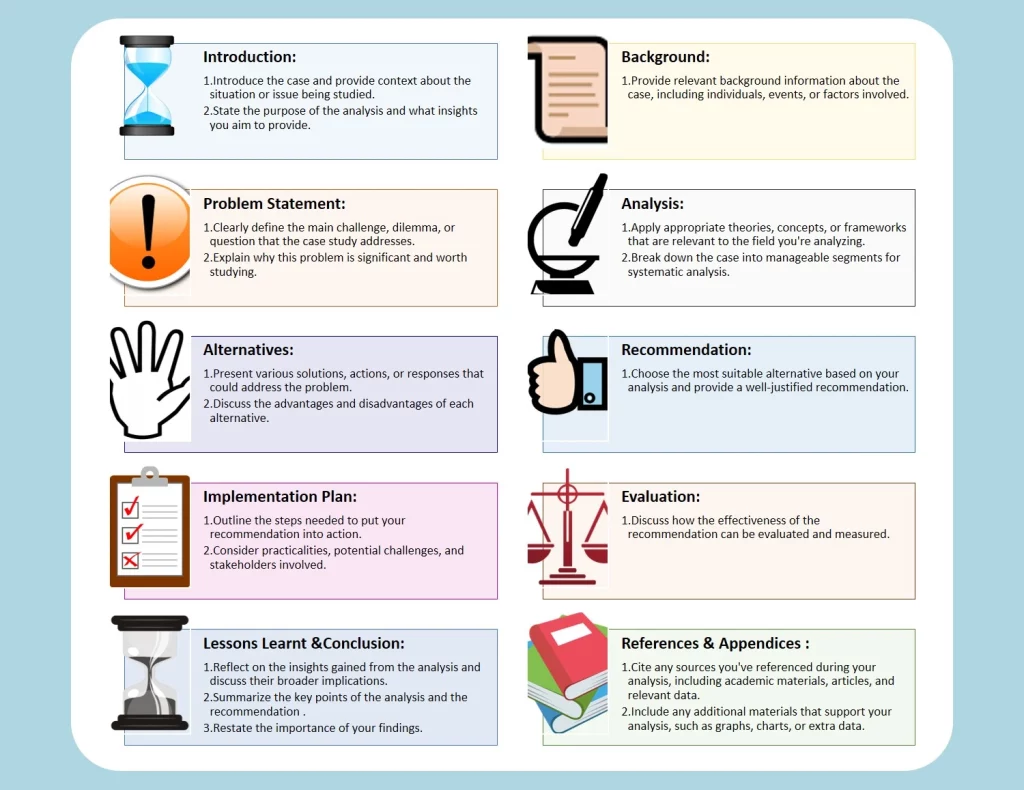
A case study analysis is a research method and written report that involves an in-depth examination of a specific instance or case, often within the context of a particular field or discipline. The goal of a case study analysis is to gain a comprehensive understanding of the subject matter by exploring its complexities, dynamics, and nuances.
Here is a sample business case study analysis paper:
Business Case Study Analysis Paper: Airbnb
Key Elements
- Selection of a Case: The process begins with the selection of a relevant and specific case, which could be an individual, organization, event, or situation. The choice should align with the research question or objective.
- Data Collection: Researchers collect data related to the case through various methods, such as interviews, observations, surveys, documents, and historical records. The data can be qualitative or quantitative, depending on the research approach.
- Analysis of Data: The collected data is carefully analyzed to identify patterns, themes, relationships, and key insights. This often involves using analytical frameworks and tools specific to the research area.
- Contextualization: The case is situated within its broader context, allowing researchers to understand how it fits into the larger picture and how external factors may influence the case.
- Findings: The analysis generates findings and discoveries that answer the research questions or address the research objectives. These findings should be well-documented and supported by evidence from the data.
- Discussion: Researchers discuss and interpret the findings, considering the implications and relevance of their results. They may compare their case to existing literature or theory.
- Conclusion: The case study analysis concludes with a summary of the key findings and the broader significance of the case in the context of the research.
- Recommendations: In some cases, recommendations or insights for practical applications or further research may be provided.
- Writing the Case Study Analysis Paper: The entire process is documented in a written report or paper, which follows a structured format, including an introduction, methodology, findings, discussion, and conclusion sections. Proper citations and references are essential.
Case study analyses are widely used in various fields, including business, psychology, sociology, medicine, and education, as they provide a detailed and holistic understanding of complex issues or phenomena. They serve as valuable tools for research, problem-solving, and decision-making.
Case Study Analysis as a Research Methodology
Qualitative Case Study Analysis

Qualitative case study analysis is a valuable methodology for exploring complex social, behavioral, and organizational phenomena, providing a deeper understanding of the subject matter and contributing to the development of theory and knowledge in various disciplines.
What to include in a qualitative case study analysis?
A qualitative case study analysis should include several key components to provide a comprehensive and meaningful understanding of the case under investigation. Here is an outline of what to include in a qualitative case study analysis:
- Introduction:
- Case Description:
- Theoretical Framework: If applicable, present the theoretical framework or relevant literature that guides your analysis and helps interpret the findings.
- Methodology:
- Data Presentation:
- Data Analysis:
- Findings:
- Discussion:
- Conclusion:
- Limitations: Acknowledge any limitations of the case study analysis, such as issues related to generalizability, data quality, or potential biases.
- Recommendations (if applicable): Offer practical recommendations, if appropriate, based on your analysis and findings.
- References: Cite all sources, literature, and documents used in your analysis, following the appropriate citation style.
- Appendices (if needed): Include supplementary materials, such as interview transcripts, additional data, or detailed coding schemes, in the appendices.
Remember that the structure and content of a qualitative case study analysis may vary depending on the research objectives, the nature of the case, and the specific guidelines provided by your academic institution or research publication. It’s essential to maintain a clear and organized presentation of your analysis to ensure its comprehensibility and credibility.
Quantitative Case Study Analysis

A quantitative case study analysis is a research methodology that involves the systematic collection and analysis of numerical data to study a specific case within its real-world context. It combines the in-depth examination of a case with the application of quantitative research techniques.
What to include in a quantitative case study analysis?
In a quantitative case study analysis, you should include the following key components to provide a comprehensive and rigorous examination of a specific case using quantitative research methods:
- Introduction:
- Case Description:
- Theoretical Framework (if applicable): Introduce the theoretical framework or relevant literature that guides your analysis and informs the development of hypotheses.
- Methodology:
- Data Presentation:
- Data Analysis:
- Discussion:
- Conclusion:
- Limitations: Acknowledge any limitations of the quantitative case study analysis, such as issues related to generalizability, data quality, or potential biases.
- Recommendations (if applicable): Offer practical recommendations or suggestions based on the quantitative analysis and its implications.
- References: Cite all sources, literature, and documents used in your analysis, following the appropriate citation style.
- Appendices (if needed): Include supplementary materials, such as questionnaires, survey instruments, or detailed statistical output, in the appendices.
While this structure provides a general framework for a quantitative case study analysis, it’s essential to adapt the organization and content to suit the specific research focus, the nature of the case, and any guidelines or requirements provided by your academic institution or publication. The goal is to ensure clarity and coherence in presenting your quantitative research findings.
Steps on How to Write

Writing an effective case study analysis involves a systematic process that helps you present your findings and insights in a clear and compelling manner. Here are the steps to follow when writing a case study analysis:
- Understand the Case: Begin by thoroughly understanding the case you’re analyzing. Familiarize yourself with the key details, context, and any relevant background information.
- Define the Research Questions or Objectives: Clearly define the research questions or objectives that your case study analysis aims to address. This step will guide your research and analysis.
- Select a Theoretical Framework (if applicable): If your analysis is guided by a theoretical framework, choose or develop one that is relevant to your case study.
- Data Collection: Collect data relevant to your case, such as interviews, surveys, observations, and documents. Ensure that your data collection methods align with your research questions and objectives.
- Organize and Analyze Data: Systematically organize and analyze the collected data. Use appropriate data analysis techniques, such as coding, thematic analysis, or statistical analysis, depending on whether it’s a qualitative or quantitative case study.
- Identify Key Findings: Identify the key findings and insights that emerge from your data analysis. Highlight patterns, themes, or significant results.
- Structure Your Case Study Analysis:
- Introduction:
- Provide an overview of the case and its significance.
- Case Description: Offer a detailed description of the case, including context, key events, and the people involved.
- State your research questions or objectives.
- Methodology:
- Describe your research design, data collection methods, and data analysis techniques.
- Include ethical considerations
- Data Presentation and Analysis:
- Present your findings, using tables, charts, graphs, and statistics as needed.
- Discuss the implications of your findings and how they relate to your research questions.
- Discussion:
- Interpret your findings in the context of the theoretical framework or relevant literature (if applicable).
- Discuss the significance and practical implications of your research.
- Conclusion:
- Summarize the key findings and their importance.
- Mention any limitations and the potential for future research.
- Recommendations (if applicable):
- Offer practical recommendations or insights based on your analysis.
- Offer recommendations for future research.
- Introduction:
- Draft the Case Study Analysis Paper:
- Cite Sources: Properly cite all sources, literature, and documents used in your analysis. Follow the appropriate citation style (e.g., APA, MLA, Chicago).
- Peer Review: Seek feedback from peers or mentors to review your analysis and provide suggestions for improvement.
- Revise and Finalize: Based on feedback, revise and finalize your case study analysis to ensure that it meets the necessary standards of quality and accuracy.
- Attach Supporting Materials (if needed): Create any supplementary materials, such as appendices with additional data, transcripts, or detailed tables, to provide more in-depth information to interested readers.
- Revise and refine one last time before submitting the case analysis paper.
Writing an effective case study analysis requires attention to detail and a structured approach. By following these steps, you can present your analysis in a well-organized and persuasive manner, making it valuable for both academic and practical purposes.
Case Study Analysis in Various Disciplines
Case Study Analysis in Business
The format of a case study analysis in business typically follows a structured outline to present your analysis and findings in a clear and organized manner. Here is a suggested format for a case study analysis in business:
- Title Page:
- Table of Contents: List of sections and subsections with page numbers.
- Executive Summary:
- Introduction:
- Introduce the case and its relevance.
- Case Description:
- Problem Identification:
- State the purpose and objectives of the analysis.
- Present the research questions or hypothesis.
- Theoretical Framework (if applicable): Introduce the theoretical framework or relevant business concepts that inform your analysis. i.e.:
- Methodology:
- Data Presentation and Analysis:
- Discussion of Findings:
- Recommendations:
- Implementation Strategies:
- Conclusion:
- References: Cite all sources, literature, and documents used in your analysis, following the appropriate citation style (e.g., APA, MLA).
- Appendices (if needed): Include supplementary materials, such as questionnaires, survey instruments, detailed data tables, or additional information that enhances the understanding of the case.
In summary, a business case study analysis is a detailed examination of a real-world business situation, often involving a company or industry. It aims to understand, analyze, and draw insights from the case, addressing specific research questions or objectives. The analysis may involve data collection, application of relevant theories, and the formulation of recommendations or solutions based on the findings. Business case study analysis is used for learning, problem-solving, and decision-making in the business context.
Case Study Analysis in Social Sciences
The format of a case study analysis in social sciences typically follows a structured and organized layout to ensure clarity and coherence. Here’s a commonly used format for a case study analysis in psychology and other social sciences:
- Title Page:
- Executive Summary: A brief, one-paragraph summary of the key findings and the purpose of the analysis.
- Table of Contents: List of sections and subsections with page numbers for easy navigation.
- Introduction:
- Provide an overview of the case study and its significance in the social sciences.
- Case Description:
- State the research questions, objectives, or the social issue to be addressed.
- Offer a preview of the structure of the analysis.
- Theoretical Framework (if applicable): Introduce the theoretical framework or relevant social science theories that guide your analysis i.e.:
- Methodology:
- Data Presentation and Analysis:
- Discussion:
- Conclusion:
- Recommendations (if applicable): Provide practical recommendations or policy implications based on the analysis.
- References: List all sources, literature, and documents cited in the analysis, following the appropriate citation style (e.g., APA, MLA).
- Appendices (if needed): Include supplementary materials, such as interview transcripts, additional data, or detailed coding schemes, in the appendices.
In summary, case study analysis in social sciences involves an in-depth investigation of a specific real-life situation or phenomenon within its natural context. Researchers gather data using various methods, such as interviews, observations, or document analysis, to explore complex social issues, behaviors, and processes. The analysis seeks to generate insights, identify patterns, and provide a comprehensive understanding of the case. This method is commonly used in sociology, psychology, anthropology, and other social sciences to contribute to the body of knowledge and inform social theory and practice.
Case Study Analysis in Nursing
A nursing case study analysis is a comprehensive examination of a specific clinical situation, often involving a patient’s health condition or nursing care. It aims to understand, analyze, and draw insights from the case, addressing specific clinical questions or objectives. The analysis typically involves clinical data collection, application of relevant nursing theories, and the formulation of recommendations or care plan modifications based on the findings. Nursing case study analyses serve to inform clinical practice and enhance patient care.
7 Major Mistakes to Avoid
- Lack of Clear Research Objectives:
- Insufficient Data Collection:
- Inadequate Analysis Methods:
- Ignoring Theoretical Frameworks:
- Bias and Subjectivity:
- Neglecting Contextual Factors:
- Ineffective Writing & Communication:
By avoiding these common mistakes and following best practices in case study analysis, you can enhance the quality, credibility, and impact of your research.
Frequently Asked Questions (FAQs)
-
Why is a case study analysis approach used in academia and research?
Case study analysis is employed in academia and research for several reasons:
- In-depth Exploration: It allows for a comprehensive examination of complex real-world phenomena, providing insights that may be missed in broader studies.
- Contextual Understanding: It enables researchers to study a subject within its natural context, considering the unique circumstances and factors that influence it.
- Theory Testing and Development: Case studies help test and refine existing theories or develop new ones.
- Practical Application: Findings from case studies can inform practical decision-making in fields like business, healthcare, and social sciences.
-
How do I select an appropriate case study for analysis?
To choose an appropriate case study, consider these factors:
- Relevance: Ensure the case aligns with your research objectives and questions.
- Significance: Select a case that has importance in your field or for the issues you want to explore.
- Availability of Data: Ensure that sufficient and accessible data or information is available for analysis.
- Feasibility: Assess whether you have the resources and time to conduct the analysis effectively.
- Diversity: Choose a case that offers diversity in terms of variables, contexts, or conditions for richer insights.
-
What’s the difference between qualitative and quantitative case study analysis, and when should I use each approach?
- Qualitative Case Study Analysis:
- Focuses on understanding complex phenomena and exploring in-depth insights.
- Utilizes non-numerical data (e.g., interviews, observations, documents).
- Useful for research where context and rich descriptions are vital.
- Quantitative Case Study Analysis:
- Employs numerical data and statistical techniques to quantify variables and relationships.
- Suitable for examining patterns, relationships, and causality.
- Appropriate when a structured, numerical analysis is needed.
- Qualitative Case Study Analysis:
-
What data collection methods are commonly used in case study analysis, and how do I choose the right one for my study?
- Common data collection methods include interviews, surveys, observations, document analysis, and archival research.
- Choose methods based on your research questions and objectives. Consider the nature of the case and the type of data needed. Triangulation (using multiple methods) can enhance data validity.
-
What is the role of a theoretical framework in a case study analysis, and how do I select an appropriate framework?
- A theoretical framework provides a lens through which to interpret case study findings and guides the analysis.
- Select a framework relevant to your research objectives and the nature of the case. The framework should offer concepts and principles that help make sense of the data and draw meaningful conclusions.
-
How do I ensure the credibility and validity of my case study analysis findings?
To ensure credibility and validity, employ the following strategies:
- Use multiple sources of data to triangulate findings.
- Maintain detailed records of data collection and analysis.
- Engage in peer debriefing or external review to check for bias and errors.
- Apply systematic data analysis techniques.
- Address any potential researcher bias and maintain transparency in your methodology.
-
What are the best practices for presenting and communicating the results of a case study analysis effectively?
To present results effectively:
- Use a structured format with clear headings.
- Provide context, including a thorough case description.
- Use visuals (tables, charts) to illustrate findings.
- Explain implications and practical significance.
- Engage the reader with clear, concise, and organized writing.
-
Case study analysis tools and software?
- Various tools and software can aid in case study analysis, including:
- Qualitative Analysis Software: NVivo, MAXQDA, Atlas.ti for managing and analyzing qualitative data.
- Statistical Software: SPSS, R, SAS for quantitative data analysis in case studies.
- Mind Mapping and Diagramming Tools: Tools like MindMeister or Lucidchart can help with visualizing case relationships.
- Literature Review Software: Tools like EndNote or Zotero can assist in managing references and literature reviews.
- The choice of tools depends on your specific research needs and the nature of your case study analysis.
- Various tools and software can aid in case study analysis, including:
In conclusion, the key to writing a successful case study analysis paper is to have a thorough understanding of the case, define clear research objectives, apply a structured approach to data collection and analysis, and present your findings and insights in a well-organized, clear, and persuasive manner.
